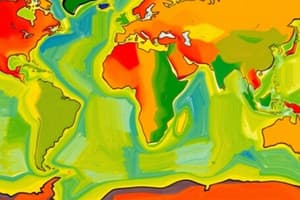Podcast
Questions and Answers
What does Physical Geography primarily study?
What does Physical Geography primarily study?
- Human cultures and economies
- Natural features and processes (correct)
- Geographical information systems
- Movements of people and goods
Which term describes the unique characteristics of a location?
Which term describes the unique characteristics of a location?
- Movement
- Region
- Place (correct)
- Location
What is an example of a subfield of Human Geography?
What is an example of a subfield of Human Geography?
- Soil Geography
- Climatology
- Cultural Geography (correct)
- Biogeography
Which method is primarily used for gathering geographic information using satellite images?
Which method is primarily used for gathering geographic information using satellite images?
What defines a region in geography?
What defines a region in geography?
Which climate zone is characterized as having very little precipitation?
Which climate zone is characterized as having very little precipitation?
Which of the following is a characteristic of Human-Environment Interaction?
Which of the following is a characteristic of Human-Environment Interaction?
Which tool is used to analyze spatial data and create maps?
Which tool is used to analyze spatial data and create maps?
Flashcards are hidden until you start studying
Study Notes
Definition of Geography
- Study of the Earth’s landscapes, environments, and the relationships between people and their environments.
- Involves both human and physical aspects.
Branches of Geography
-
Physical Geography
- Focuses on natural features and processes: landforms, climate, vegetation, soils, and ecosystems.
-
Human Geography
- Examines human activities, cultures, economies, and their relationships to the environment.
- Includes subfields like urban geography, cultural geography, and political geography.
-
Geographical Techniques
- Geographic Information Systems (GIS)
- Remote sensing
- Cartography (map-making)
Key Concepts
-
Location
- Absolute Location: Exact coordinates (latitude and longitude).
- Relative Location: Position relative to other locations.
-
Place
- Characteristics that make a location unique (physical and human attributes).
-
Region
- Areas defined by shared characteristics (cultural, political, physical).
- Types: Formal, Functional, Vernacular.
-
Movement
- How and why people and goods move from one place to another.
-
Human-Environment Interaction
- Ways humans adapt to and modify their environment.
Physical Geography Features
-
Landforms
- Mountains, valleys, plains, plateaus, and hills.
-
Climate and Weather
- Climate zones: tropical, arid, temperate, polar.
- Weather patterns and phenomena.
-
Ecosystems
- Biomes: deserts, forests, tundra, grasslands, aquatic.
Human Geography Features
-
Population
- Distribution, density, and demographics.
-
Culture
- Language, religion, customs, and traditions.
-
Economy
- Types: agriculture, industry, services.
- Globalization and trade networks.
Tools and Methods
-
Maps
- Types: topographic, thematic, political, and climate maps.
-
GIS and Spatial Analysis
- Tools for analyzing spatial data and mapping.
-
Remote Sensing
- Use of satellite images to gather geographic information.
Current Trends in Geography
- Climate change and its impact on human and physical geography.
- Urbanization and its effects on land use and populations.
- Geopolitical issues and territorial disputes.
Definition of Geography
- Geography studies the Earth’s landscapes, environments, and interactions between people and their surroundings.
- It encompasses both human (social) and physical (natural) aspects.
Branches of Geography
- Physical Geography: Investigates natural features including landforms, climate, vegetation, soils, and ecosystems.
- Human Geography: Analyzes human-related activities like cultures and economies concerning the environment; includes urban, cultural, and political geography.
- Geographical Techniques:
- Geographic Information Systems (GIS): Tools for mapping and analysis.
- Remote Sensing: Collecting data using satellite imagery.
- Cartography: The art and science of map-making.
Key Concepts
- Location:
- Absolute: Specific coordinates (latitude and longitude).
- Relative: Position in relation to other places.
- Place: Unique characteristics of a location, encompassing both physical features and human attributes.
- Region: Areas defined by shared characteristics; can be formal (government-defined), functional (based on connections), or vernacular (perceptual).
- Movement: The dynamics of how and why people and goods transit between locations.
- Human-Environment Interaction: Examines the modifications humans make to their environment and adaptations to it.
Physical Geography Features
- Landforms: Different topographical features including mountains, valleys, plains, plateaus, and hills.
- Climate and Weather:
- Climate zones such as tropical, arid, temperate, and polar describe long-term weather patterns.
- Ecosystems: Various biomes such as deserts, forests, tundra, grasslands, and aquatic environments.
Human Geography Features
- Population: Focuses on aspects like distribution, density, and demographic characteristics.
- Culture: Encompasses language, religion, customs, and traditions of a population.
- Economy: Covers sectors like agriculture, industry, and services, along with globalization and trade networks.
Tools and Methods
- Maps: Various types including topographic (elevation), thematic (thematic data), political (boundaries), and climate (weather patterns).
- GIS and Spatial Analysis: Analytical tools for spatial data interpretation and mapping.
- Remote Sensing: Employs satellite imagery to collect and analyze geographic data.
Current Trends in Geography
- Climate change increasingly affects both human and physical geography.
- Urbanization altering land use patterns and influencing population distributions.
- Ongoing geopolitical issues and territorial disputes among nations.
Studying That Suits You
Use AI to generate personalized quizzes and flashcards to suit your learning preferences.




